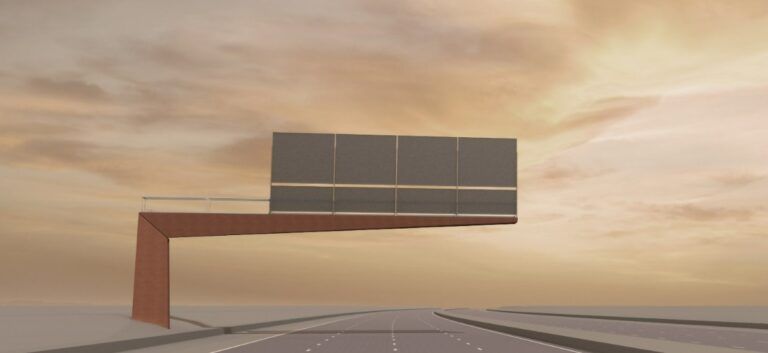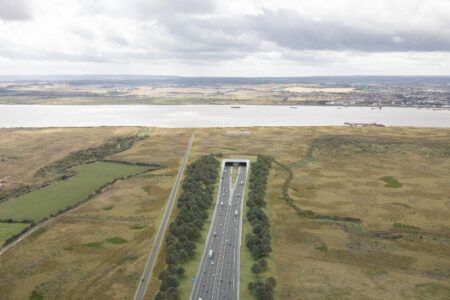National Highways in the UK has unveiled the winning design in its Gantry of the Future competition, which sought to gather ideas for a more streamlined, elegant and consistent visual appearance for roadside gantries on its motorways and major A-roads to enhance the public’s driving experience.
The winning entry (pictured top), created by Useful Studio, features a simple, pared-back design approach. It was chosen by the judging panel for its elegance, simplicity and sustainability, and how cohesive the design concept was across a range of different structures.
Useful Studio will now work with National Highways to develop its design concept, with a view to it becoming the standard design for new roads and major upgrades from around two years’ time.
Useful Studio’s winning entry uses less steel than existing gantry designs, meaning less embodied carbon, and the use of pre-weathered rather than painted steel. The design follows existing best practice from other highways structures and ages better than painted steel, meaning potentially lower maintenance requirements and fewer lane closures and delays for drivers.

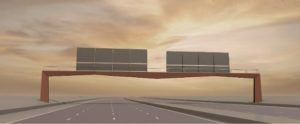
The design can also be adapted for different types of structures including those spanning all carriageways and roadside signs.
National Highways executive director for operations, Duncan Smith, said, “Existing designs tend to emphasize function over form, our challenge is to create innovative structures that can accommodate the required signage and equipment that are more sympathetic to the environment.
“In selecting Useful Studio as the winner, the judging panel admired the simplicity and elegance of the pared-back design approach, and the opportunities it presented in terms of a resource efficient, standardized, coherent suite of gantry structures that would be potentially sympathetic to a broad range of settings and contexts,” Smith added.
Although security issues did not form part of the original specification, Useful Studio’s design will be more resilient to trespassers due to entry being concealed within the pillars, making it more difficult to access without authorization.
The Gantry of the Future competition was organized by National Highways in conjunction with the Royal Institute of British Architects (RIBA), with 32 entries from architectural firms from across the UK and Europe.
Other entries also demonstrated a range of fresh thinking and innovation in approach to the design, including wood composite and LED panel-based designs, as well as identifying the challenge of removing gantries completely in favor of in-vehicle displays.
A design by John McAslan+Partners won second place in the competition and three other concepts were highly commended by the judging panel, which was made up of experts in the architectural and highways fields.
Runner-up

John McAslan+Partners – in selecting this design as the runner-up, the judging panel admired the clarity and dynamism of the proposition which articulated the distinction between a sculptural primary mast and cable-stayed lightweight modular gantry truss, that had the potential to be developed into an elegant family of structures.
Commended schemes
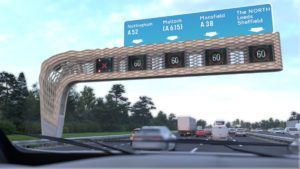
Kevin Kelly Architects and Stand Engineers – this submission was commended by the judging panel for its incorporation and best proposed use of timber componentry.
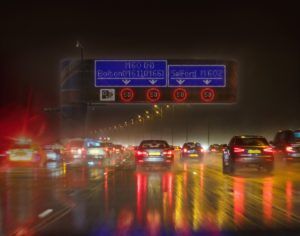 Hooman Talebi with Farshad Nasiri, Ehsan Masoud, Minoo Mashhadi, Raziyeh Rasapour, and Homa Farjadi (Design Advisor) – this submission was commended by the judging panel for its proposed use of digital screen technology to turn the gantry into a singular information-based object.
Hooman Talebi with Farshad Nasiri, Ehsan Masoud, Minoo Mashhadi, Raziyeh Rasapour, and Homa Farjadi (Design Advisor) – this submission was commended by the judging panel for its proposed use of digital screen technology to turn the gantry into a singular information-based object.
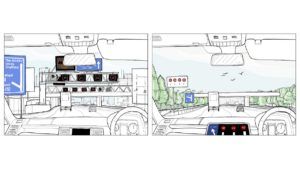
Knight Architects – this submission was commended by the judging panel for proposing the best challenge to the continued and future need for overhead gantry structures.


